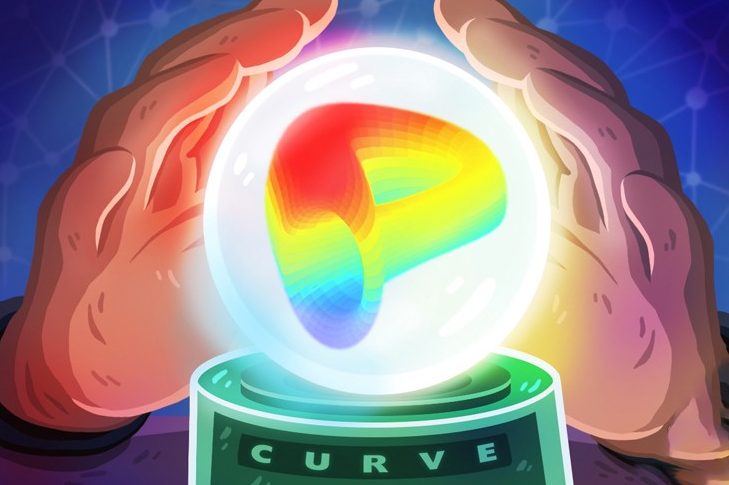Introduction to CURVE.fi
Curve is an Automated Market Maker that gathers around $20B of market cap across 8 chains which makes it the most important DeFi pool as of today. The mathematics behind it is bespoke. Their algorithm allows for a very high transaction volume with extremely low slippage.
Curve tokenomics are also very generous, splitting its transaction fees between CRV token holders. It is a DEx, sort of like Uniswap where you trade with a protocol, an automated pool and not directly with another trader. But the main difference with Uniswap is it specialises in stablecoins and similar types of tokens.
Uniswap is a constant product such as X x Y = K, which works fairly well, but can run into some issues and can produce more slippage. Michael Egorov, the founder of Curve, demonstrates in his Whitepaper how he figured out a way to combine a linear constant with a product constant that allows having such a low slippage while using Curve pools.
The Curve AMM is really optimised to trade like-kind assets in the way that even if the 2 assets aren’t equally weighted in the pool, they can still be on a 1:1 price.
Curve’s daily transactions volume is around $1B and, in fact, it even tends to spike a little during Bear Markets because many people need money quickly, covering their leveraged position. Curves routinely exceeded $1B, sometimes close to $2B, on transaction volume per day during the market dip of the last few weeks.
Quick Recap on Curve’s Tokenomics
The value behind the Curve token is split in two. There is the revenue share component and the governance aspect of it.
For every trade that occurs on Curve, liquidity providers earn a percentage of fees in the form of $CRV tokens. Curve users lock their $CRV to get a veCRV (Vote-Escrowed). The lockout period can be set between 1 week and 4 years.
However, once you lock your veCRV, you will not be able to retrieve it until the lock period expires and you will no longer be able to redeem your CRV.
At the end of the period you get your CRV back and Curve will pay you additional CRV in proportion to the veCRVs that have been locked in order to induce a long lock-in period.
The system is designed to provide 1veCRV per 1CRV for 4 years lock-in, 0.5veCRV for 2-year lock-in and 0.25veCRV for 1-year lock-in. Also, the longer you lock, the higher bonus reward you will get while providing liquidity on a pool.
To sum up, locking ur CRV for veCRV gives these rights:
- Governance: vote power in the DAO to influence which pool gets the best reward in additional CRV
- Revenue: 50% of all transaction fees are equally split between the CRV holders.
Currently, Curve has a lock-up rate of almost 50% of the amount of CRVs in circulation, with an average lock-up period of 3.63 years. Even if the full supply of Curve tokens is set up to be complete in 300 years, the curve emission strategy is very aggressive as it’s inflating at an insane amount. The only reason it’s not resulting in a complete dump of the token’s value is that everyone’s locking it up for 4 years, then locking their reward for 4 years too, and then re-locking the reward that they get for 4 more years so that they can get more reward. A virtuous circle, as long as most of the LPs stay in the circle.
veCRV, The Sinews of War
The veCRV is a governance token used to vote on any proposal made by Curve’s DAO. It can be a change in one of the many pools, a proposal for a new pool or a change in gauge weight, the additional CRV rewarded for locking cash into a pool.
The more veCRV a user locks-in, the more power he will have over the vote, as the veCRV holders represent an asset for any protocol that wishes to improve reward on its pool and therefore its TVL.
And this is where the fun part begins. The veCRV is now the most wanted token for any pool on Curve and its holders are being bribed in exchange for their vote.
The more CRV you hold the more veCRV you can get, the more you can control the emission on Curve and get a boosted reward.
This means that different projects having a pool on Curve want to have more veCRV and more voting power, meaning that they can control emission, get more revenue and a huge TVL.
Convex Takeover
Let’s go back to May 2021: Yearn, Convex & StakeDAO are fighting to accumulate veCRV in order to gain power and influence gauge vote.
Convex changed the game for good, with a very simple strategy to get the precious veCRV. They found a way to incentivise veCRV holders to give it to them directly and now Convex controls for approximately 45% of the voting power on Curve (45% of the veCRV).
Those who stake their CRV on Convex receive cvxCRV, a token that holds no voting rights. But Convex offers users the same returns as Curve, with additional $CVX rewards.
They have now accumulated so much veCRV that they created their own version of a governance token vlCVX (vote-locked Convex) to let CVX holders vote on what Convex should do with their veCRV.
In summary, Convex’s DAO now almost runs Curve’s DAO.
Convex also recently added the FRAX category in the same way as for cvxCRV users will be able to lock our $FXS in cvxFXS. Why deposit $FXS in FRAX when you can deposit it on convex and earn an additional return in $CVX?
Convex controls more than just $CRV, it now controls $FXS. Convex has generated $610m since launching in May.
One DAO to rule them all.
Bribing of CVX Holders
Everyone wants a piece of the pie. Now, platforms dedicated to bribing are being created. On Votium and Bribe.crv you can cast your vote to get additional rewards.
FRAX MIM and UST are three new stablecoins, eager to earn liquidity, like everyone else. To initiate this, they distributed bribes and other rewards to obtain veCRV votes on Votium. Frax is often leading the bribing rounds of votium, supplying more than $7M CVX voters.
Votium already controls an impressive voting capacity: approximately 8M CVX or more than 102M VeCRV. Bribing has become an essential tool to launch your stablecoin. If you don’t take control of it, you’ll be ridiculed even if you have great seed investors and real backing. The market doesn’t care.
This opens it up to other protocols to basically bribe CVX holders to incentivise the pool they want them to vote on. The 11th Votium round concludes with $16.06m in incentives for $CVX voters, $1.35m higher than the last round.
Focus on Abracadabra. Money, one of the few protocols that have understood the power of the model.
Abracadabra is a service similar to Maker. Various assets are accepted as collateral, including interest-bearing assets such as xSUSHI and cvx3pool. Just as Maker produces DAI, Abracadabra produces a stablecoin (on the dollar) called MIM.
The liquidity available on MIM, as well as the opportunity for returns, is, therefore, a key factor in the platform’s success. In a few weeks, the MIM pool has exploded on Curve, at all levels: CRV yields were really good in some weeks.
This has attracted liquidity and volume, slightly reducing the yield but increasing the ability to boost the pool As a result of this momentum, MIM is now the fifth-largest pool curve in terms of volume, with a nice volume/TVL ratio.
Abracadabra has progressively gone through all forms of direct or indirect bribes on Curve :
1. It started with a SPELL incentive (governance token) on the Curve/MIM pool.
2. When bribe.crv arrived, a portion of that incentive was reallocated to bribe – thus distributed to veCRV owners who vote for the MIM gauge.
3. Now, with the arrival of vlCVX, the team is considering reallocating the budget.
The example of Abracadabra is extremely instructive since it demonstrates all the relevance of the abstractions built on VeCRV. Without increasing its total budget, Abracadabra was able to attract much more liquidity than at the time of the simple incentive directly in SPELL.
Angle, one of the most important euro-pegged stablecoins, seems to be going in the same way: focusing on bribes, as they have a better ROI than simple pool rewards.
They could adopt a strategy in a similar way as Olympus did, but to acquire CVX. “agCVX – CVX” locked on angle contracts to boost staking rewards for example.
The goal would be to accumulate as much CVX as possible. Supply is limited. Angle needs to position itself as the powerful forex DAO, euro focused.






great piece